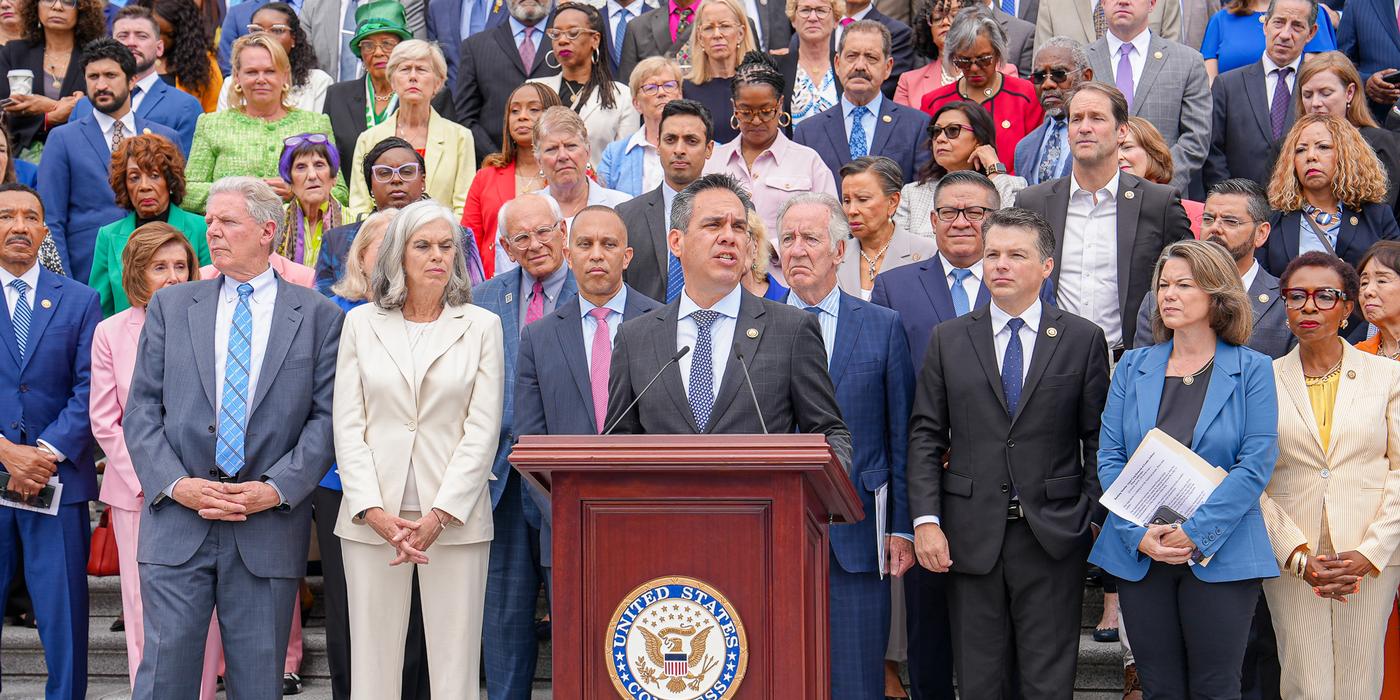The Democratic Caucus works with every Democratic member of the House of Representatives to help achieve consensus, bring their ideas and work to the forefront and ensure members have the tools they need to implement their goals. It is the only subgroup within the House of which every Democrat is a Member.
The Caucus nominates and elects the House Democratic Leadership, approves committee assignments, makes Caucus rules, enforces party discipline, and serves as a forum to develop and communicate party policy and legislative priorities. It accomplishes these tasks through weekly Caucus Meetings, on-going Issue Task Forces, the yearly Caucus Issues Conference, periodic special events and continual Member-to-Member communication.
Since its first meeting on April 2, 1796 – to oppose a treaty with Great Britain that did not adequately protect American sailors – the Caucus has functioned as a key vehicle for developing Democratic policy and strategy. From 1796 to 1820, for example, the Caucus nominated presidential candidates (and eventual presidents) Thomas Jefferson, James Madison and James Monroe. And in the late 1930s, the Caucus played a key role in preserving Democratic unity and protecting President Franklin D. Roosevelt’s “New Deal” from aggressive Republican opposition.
The Caucus has also played a major role in efforts to reform the House of Representatives. In 1910, for example, the Caucus joined Progressive Republicans in opposing the tyrannical rule of Speaker Joseph Cannon (a Republican). And in the 1960s and 1970s, the Caucus was the vehicle for institutional reforms that democratized the House, made party Leaders more accountable and increased the role of rank-and-file Members.
The Chairman and Vice Chair of the Democratic Caucus are elected by all the Democratic Members of the House of Representatives before the beginning of each Congress.
With the assistance of the Vice Chair, the Caucus Chairman sets the agenda for and presides over weekly Caucus meetings and other official activities. The Chairman establishes the Caucus Issue Task Forces – through which legislative and party policy is developed and communicated – and appoints Members to lead each one. And at least once a year, the Chairman designs, organizes and implements the Caucus Issues Conference.
Former Democratic Caucus Chairmen include former Democratic Leader Richard A. Gephardt (MO) as well as former Speakers Sam Rayburn (TX), John W. McCormack (MA) and Thomas S. Foley (WA), former United States Secretary of Health and Human Services Xavier Becerra (CA), former Assistant Leader and Whip James E. Clyburn (SC), and current Leader Hakeem Jeffries (NY). Among those distinguished former House Members who have held the Vice Chair position are 1984 Democratic Vice Presidential nominee Geraldine A. Ferrarro (NY) and former Caucus Chairman Vic Fazio (CA).
Current Democratic Caucus Chairman Pete Aguilar (CA) and Vice Chair Ted Lieu (CA) were elected by their Democratic colleagues in the House for the 119th Congress.
"THE DEMOCRATIC CAUCUS IS THE INSTITUTION OF THE HOUSE OF REPRESENTATIVES WITH THE LONGEST CONTINUOUS EXISTENCE WITH THE EXCEPTION OF THE SPEAKERSHIP ITSELF….[IT IS] THE SINGLE AND UNIQUE POINT OF CONVERGENCE WHERE MATTERS AFFECTING ALL OF THE PARTY’S ADHERENTS IN THE CHAMBER CAN BE DISCUSSED."
— A Short History of the Democratic Caucus, Ross K. Baker, Professor of Political Science, Rutgers University


